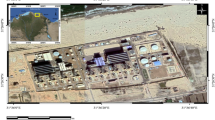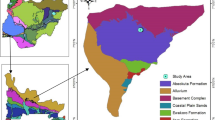Abstract
Recently, groundwater resources of the coastal aquifers attract the attention of arid countries such as Egypt. West Port Said coast is one of those areas, which is depending on groundwater for urban and industrial expansions. Usually, groundwater exploration in such coastal areas is considered as one of the most difficult challenges due to its highly conductive substrata and seawater intrusion. Thus, the main objective of this research is determining the best hydro-geophysical method, which shows the high accuracy results with less ambiguity in exploring the coastal aquifer in the west Port Said coastal study area, which was a part of Manzala Lagoon as inferred from the processed satellite images. Meanwhile, the vertical electrical sounding (VES) and transient electromagnetic (TEM) have become the most popular hydro-geophysical techniques, which are widely used to explore and locate groundwater resources. In this study, a total of five VES and eight TEM soundings were carried out and correlated with the nearby drilled wells. The results showed that the electrical current of the VES method cannot penetrate deeper than 10 m due to the presence of saline materials that obscured the current to pass through and cannot distinguish clearly between the subsurface conductive layers and suffers from high ambiguity. While the TEM method has provided fast, relatively accurate results, deeper (300-m depth) and has the ability to distinguish clearly between the subsurface conductive layers compared with VES technique. Consequently, the TEM method showed many comparable and less ambiguous results to the drilled wells and suitable for such coastal environments.










Similar content being viewed by others
References
Adepelumi AA, Ako B, Ajayi T, Afolabi O, Omotoso E (2009) Delineation of saltwater intrusion into the freshwater aquifer of Lekki Peninsula Lagos, Nigeria. Environ Geol 56:927–933
ASTM (2011) Standard guide for selecting surface geophysical methods, Designation: D6429-99, American Society for Testing Materials
Badon-Ghyben W (1889) Notes on the probable results of the proposed well drilling near Amsterdam. K Inst Ing Tijdschr, The Hague 2
Barlow PM, Reichard EG (2010) Saltwater intrusion in coastal regions of North America. Hydrogeol J 18:247–260
Barsukov PO, Fainberg EB, Khabensky EO (2015) Shallow investigations by TEM-FAST technique: methodology and examples. Electromagnetic sounding of the Earth’s interior. Elsevier, Amsterdam, pp 47–78
Bear J, Dagan G (1964) Some exact solutions of interface problems by means of the hodograph method. J Geophys Res 69:1563–1572
Bear J, Cheng AH-D, Sorek S, Ouazar D, Herrera I (1999) Seawater intrusion in coastal aquifers: concepts, methods and practices, vol 14. Springer Science & Business Media, Dordrecht
Bhattacharya A, Patra H (1968) Direct current geoelectric prospecting. Elsevier, Amsterdam
Chen CS (1999) TEM investigations of aquifers in the southwest coast of Taiwan. Groundwater 37:890–896
Choudhury K, Saha D (2004) Integrated geophysical and chemical study of saline water intrusion. Groundwater 42:671–677
Christensen NB, Sørensen KI (1998) Surface and borehole electric and electromagnetic methods for hydrogeological investigations. Eur J Environ Eng Geophys 3:75–90
Colombani N, Osti A, Volta G, Mastrocicco M (2016) Impact of climate change on salinization of coastal water resources. Water Resour Manag 30:2483–2496
Comte JC, Banton O (2007) Cross‐validation of geo‐electrical and hydrogeological models to evaluate seawater intrusion in coastal aquifers. Geophys Res Lett 316:34
Danielsen JE, Auken E, Jørgensen F, Søndergaard V, Sørensen KI (2003) The application of the transient electromagnetic method in hydrogeophysical surveys. J Appl Geophys 53:181–198
De Breuck W, De Moor G (1969) The water-table aquifer in the eastern coastal area of Belgium. Hydrol Sci J 14:137–155
De Filippis G, Giudici M, Negri S, Margiotta S, Cattaneo L, Vassena C (2014) Numerical modeling of groundwater flow in the coastal aquifer system of Taranto (southern Italy). In: EGU General Assembly Conference Abstracts
Dobrin M (1976) Introduction to geophysical prospecting, 3rd edn. McGraw Hill, New York
Duque C, Calvache ML, Pedrera A, Martín-Rosales W, López-Chicano M (2008) Combined time domain electromagnetic soundings and gravimetry to determine marine intrusion in a detrital coastal aquifer (Southern Spain). J Hydrol 349:536–547
Essaid HI (1990) A multilayered sharp interface model of coupled freshwater and saltwater flow in coastal systems: model development and application. Water Resour Res 26:1431–1454
Farid MS (1980) Management of Groundwater System in the Nile Delta. Faculty of Engineering, Cairo University, Cairo
Fitterman DV, Stewart MT (1986) Transient electromagnetic sounding for groundwater. Geophysics 51:995–1005
Glover RE (1959) The pattern of fresh-water flow in a coastal aquifer. J Geophys Res 64:457–459
Golshan M, Colombani N, Mastrocicco M (2018) Assessing aquifer salinization with multiple techniques along the southern caspian sea shore (Iran). Water 10:348
Gonçalves R, Farzamian M, Santos FAM, Represas P, Gomes AM, de Pina AL, Almeida EP (2017) Application of time-domain electromagnetic method in investigating saltwater intrusion of Santiago Island (Cape Verde). Pure Appl Geophys 174:4171–4182
Grant FS, West GF (1965) Interpretation theory in applied geophysics. McGraw-Hill Book, New York
Guérin R, Descloitres M, Coudrain A, Talbi A, Gallaire R (2001) Geophysical surveys for identifying saline groundwater in the semi-arid region of the central Altiplano, Bolivia. Hydrol Process 15:3287–3301
Henry HR (1959) Salt intrusion into fresh-water aquifers. J Geophys Res 64:1911–1919
Herckenrath D, Odlum N, Nenna V, Knight R, Auken E, Bauer-Gottwein P (2013) Calibrating a salt water intrusion model with time-domain electromagnetic data. Groundwater 51:385–397
Herzberg A (1901) Die wasserversorgung einiger Nordseebader. J Gasbeleucht Wasserversorg 44:842–844
Himi M et al (2017) Geophysical characterization of saltwater intrusion in a coastal aquifer: The case of Martil-Alila plain (North Morocco). J Afr Earth Sci 126:136–147
Istok J (1989) Groundwater modeling by the finite element method. American Geophysical Union, Water Resources Monograph 13
Josselin De, de Jong G (1965) A many-valued hodograph in an interface problem. Water Resour Res 1:543–555
Kanta A, Soupios P, Barsukov P, Kouli M, Vallianatos F (2013) Aquifer characterization using shallow geophysics in the Keritis Basin of Western Crete Greece. Environ Earth Sci 70:2153–2165
Keller GV, Frischknecht FC (1966) Electrical methods in geophysical prospecting. Pergamon, New York
Koefoed O (1979) Geosounding principles 1: resistivity measurements. Elsevier Scientific Publishing, Amsterdam
Kontar EA, Ozorovich YR (2006) Geo-electromagnetic survey of the fresh/salt water interface in the coastal southeastern Sicily. Cont Shelf Res 26:843–851
Mabrouk M, Jonoski A, Oude Essink GH, Uhlenbrook S (2019) Assessing the fresh-saline groundwater distribution in the nile delta aquifer using a 3D variable-density groundwater flow model. Water 11:1946
Macnae JC, Lamontagne Y, West G (1984) Noise processing techniques for time-domain EM systems. Geophysics 49:934–948
Mastrocicco M, Colombani N, Sbarbati C, Petitta M (2012) Assessing the effect of saltwater intrusion on petroleum hydrocarbons plumes via numerical modelling. Water Air Soil Pollut 223:4417–4427
McCracken K, Oristaglio M, Hohmann G (1986) Minimization of noise in electromagnetic exploration systems. Geophysics 51:819–832
Meju M, Fenning P, Hawkins T (2000) Evaluation of small-loop transient electromagnetic soundings to locate the Sherwood Sandstone aquifer and confining formations at well sites in the Vale of York England. J Appl Geophys 44:217–236
Metwaly M, Khalil M, Al-Sayed E-S, Osman S (2006) A hydrogeophysical study to estimate water seepage from northwestern Lake Nasser Egypt. J Geophys Eng 3:21–27
Mills T, Hoekstra P, Blohm M, Evans L (1988) Time domain electromagnetic soundings for mapping sea-water intrusion in Monterey County California. Groundwater 26:771–782
Nabighian MN, Macnae JC (1991) Time domain electromagnetic prospecting methods. Electromagn Methods Appl Geophys 2:427–509
Oude Essink G, Van Baaren ES, De Louw PG (2010) Effects of climate change on coastal groundwater systems: a modeling study in the Netherlands. Water Resour Res 46:W00F04
Papadopoulos I, Tsourlos P, Karmis P, Vargemezis G, Tsokas G (2004) A TDEM survey to define local hydrogeological structure in Anthemountas Basin, N Greece. J Balkan Geophys Soc 7:1–11
Parasnis D (1973) Mining geophysics. Elsevier Publishers, Amsterdom
Said R (1981) The geologic evolution of the River Nile. Springer, New York
Sestini G (1989) Nile Delta: a review of depositional environments and geological history. Geol Soc Lond Spec Publ 41:99–127
Sonkamble S, Chandra S, Somvanshi V, Ahmed S (2016) Hydro-geophysical techniques for safe exploitation of the fresh groundwater resources in coastal area. Environ Earth Sci 75:279
Soupios PM, Kalisperi D, Kanta A, Kouli M, Barsukov P, Vallianatos F (2010) Coastal aquifer assessment based on geological and geophysical survey, northwestern Crete Greece. Environ Earth Sci 61:63–77
Stanley J-D, Clemente PL (2017) Increased land subsidence and sea-level rise are submerging Egypt’s Nile Delta coastal margin. GSA Today 27:4–11
Stewart MT (1982) Evaluation of electromagnetic methods for rapid mapping of salt-water interfaces in coastal aquifers. Groundwater 20:538–545
Sundararajan N, Sankaran S, Al-Hosni T (2012) Vertical electrical sounding (VES) and multi-electrode resistivity in environmental impact assessment studies over some selected lakes: a case study. Environ Earth Sci 65:881–895
Telford WM, Telford W, Geldart L, Sheriff RE, Sheriff RE (1990) Applied geophysics. Cambridge University Press, Cambridge
Trabelsi F, Mammou AB, Tarhouni J, Piga C, Ranieri G (2013) Delineation of saltwater intrusion zones using the time domain electromagnetic method: the Nabeul-Hammamet coastal aquifer case study (NE Tunisia). Hydrol Process 27:2004–2020
Van der Veer P (1977) Analytical solution for steady interface flow in a coastal aquifer involving a phreatic surface with precipitation. J Hydrol 34:1–11
Vandenbohede A, Hinsby K, Courtens C, Lebbe L (2011) Flow and transport model of a polder area in the Belgian coastal plain: example of data integration. Hydrogeol J 19:1599–1615
Verruijt A (1969) An interface problem with a source and a sink in the heavy fluid. J Hydrol 8:197–206
Werner AD et al (2013) Seawater intrusion processes, investigation and management: recent advances and future challenges. Adv Water Resour 51:3–26
Zarroca M, Bach J, Linares R, Pellicer XM (2011) Electrical methods (VES and ERT) for identifying, mapping and monitoring different saline domains in a coastal plain region (Alt Empordà, Northern Spain). J Hydrol 409:407–422
Zohdy AA (1965) The auxiliary point method of electrical sounding interpretation, and its relationship to the Dar Zarrouk parameters. Geophysics 30:644–660
Zohdy AA (1975) Automatic interpretation of Schlumberger sounding curves, using modified Dar Zarrouk functions. US Govt Print Off
Author information
Authors and Affiliations
Corresponding author
Additional information
Publisher's Note
Springer Nature remains neutral with regard to jurisdictional claims in published maps and institutional affiliations.
Rights and permissions
About this article
Cite this article
Abdelfattah, M., Gaber, A., Geriesh, M.H. et al. Investigating the less ambiguous hydrogeophysical method in exploring the shallow coastal stratified-saline aquifer: a case study at West Port Said Coast, Egypt. Environ Earth Sci 80, 159 (2021). https://doi.org/10.1007/s12665-021-09442-8
Received:
Accepted:
Published:
DOI: https://doi.org/10.1007/s12665-021-09442-8




